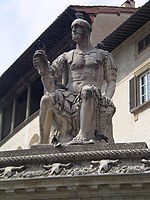Bukranion

The Bukranion (plural: Bukranien) (from ancient Greek βουκράνιον boukránion "cattle skull"), sometimes also called ox head , is the front view of a cattle skull with horns used as a decorative motif. This decorative motif was used in prehistoric times, was particularly popular in Greek and Roman antiquity and was taken up again in the Renaissance . Aigikranion stands for the front view of a goat or ram skull . In the 19th century Aaskopf was used as a generic term for Bukranien and Aigikranien.
Classical archeology
The bucranion can be painted or sculptured and comes in both naturalistic and stylized versions. At least originally, it refers to sacrificial animals . The classic Bukranion has been around since the 4th century BC. It was known as an ornament in Hellenism and by the Romans . They were used as symbols of piety on temples, portals or tombs.
In Hellenistic and Roman decorations, the individual skulls are often connected by hanging garlands , also called festons , and bowls or rosettes arranged in between to form a continuous frieze of bucrania . The tomb of Caecilia Metella can be cited as an example of a Roman building . Bucrania friezes can often be found in Roman wall paintings.
In the Renaissance , Baroque and Classicism periods , bucrania and Aigrikonia friezes were used again as decorative elements, for example in architecture and in furniture such as tables and cupboards .
prehistory

By James Mellaart bull horn pillars or replicas of bull's horns were in Çatalhöyük as bucrania referred G. Daniel took the name in his encyclopedia.
Convincing evidence of cattle skulls as architectural ornaments comes from the Pfyner culture and was found in layer III of the Arbon -Bleiche wetland settlement in Arbon, Switzerland. A total of 22 forehead skulls with horn cones were discovered here, in which the rest of the cranium was apparently separated with a blunt instrument. There were 14 cattle, six goats, one great and one bison. These skull parts were mostly found near the house walls, although houses could have up to four skulls. Deer skulls as building ornaments, but inside the house are proven from the area of the Vinča culture , z. B. in Uivar , Romania. Cattle skulls stand around like a Cheval de friese around a 4000 year old burial mound near the Sudanese city of Kerma .
Folklore
In some communities in Switzerland, skulls of cattle and goats are still attached to the outer walls of the stables.
literature
- Christoph Börker : Bukranion and Bukephalion. In: Archäologischer Anzeiger . 1975, pp. 244-250.
- Sabine Deschler-Erb, Elisabeth Marti-Grädel, Jörg Schibler: Bucrania in the Neolithic settlement Arbon-Bleiche 3. Status, cult or magic? In: as. Archeology of Switzerland. Volume 25, No. 4, 2002, ISSN 0255-9005 , pp. 25-33, doi : 10.5169 / seals-19565 .
- Hans Feldbusch: Bukranion , in: Reallexikon zur Deutschen Kunstgeschichte , Volume III (1950), Sp. 81–84. ( online )
- Adolf Ernst Napp: Bukranion and Guirlande. Contributions to the history of the development of the Hellenistic and Roman decorative arts. Bechstein, Wertheim am Main 1933, DNB 570946492 .
Web links
Individual evidence
- ↑ From an archaeological report: "the red-yellow-toned vessel fragment with the ox head frieze" ( Konrad Hörmann : The third Hallstatt level in the area of the anthropological section and the necropolis in Beckertsloh , in: Abhandlungen der Naturhistorischen Gesellschaft zu Nürnberg , Volume XXI, Nürnberg 1929, p 155-248, here p. 192). From the translation of a novel: "The meatless heads of the structural decorations named by the architects Ochsenkopf" ( Pitigrilli : Kokain , Reinbek bei Hamburg 1988, p. 21).
- ↑ Wolf-Dietrich Niemeier : A Knossische palace style shard with Bukranion depiction from Mycenae. In: Archäologischer Anzeiger 1989, pp. 5–10.
- ↑ Peter Wulf Hartmann: Kunstlexikon , Leobersdorf 1996, entries "Bukranion" and "Aigikranion".
- ↑ James Mellaart : Çatal Höyük. City from the stone age. Lübbe, Bergisch Gladbach 1967, p. 111f. He also referred to ram heads.
- ^ Glyn Daniel (ed.): Encyclopedia of Archeology. A reference work with over 1800 terms, images, maps and plans. Editor of the German edition Joachim Rehork. Weltbild-Verlag, Augsburg 1990, p. 89.
- ↑ Sabine Deschler-Erb, Elisabeth Marti-Grädel, Jörg Schibler: Bucrania in the Neolithic settlement Arbon-Bleiche 3. Status, cult or magic? In: as. Archeology of Switzerland. Vol. 25, No. 4, 2002, pp. 25-33.
- ↑ Sabine Deschler-Erb, Elisabeth Marti-Grädel, Jörg Schibler: Bucrania in the Neolithic settlement Arbon-Bleiche 3. Status, cult or magic? In: as. Archeology of Switzerland. Vol. 25, No. 4, 2002, p. 28.
- ↑ Wolfram Schier (Ed.): Catalog for the special exhibition Masks, People, Rituals. Everyday life and cult 7000 years ago in the prehistoric settlement of Uivar, Romania. Martin von Wagner Museum at the University of Würzburg, April 21 - July 10, 2005. Chair of Prehistoric and Protohistoric Archeology, Institute for Classical Studies at the University of Würzburg, Würzburg 2005, pp. 9–18, 54–61.
- Jump up ↑ Jérome Dubosson, Louis Chaix, Charles Bonnet, Matthieu Honegger: Kerma (Soudan) - origine et développement du premier royaume d'Afrique noire. In: as. Archeology of Switzerland. Vol. 32, No. 1, 2009, pp. 2–13, here p. 5.
- ↑ Sabine Deschler-Erb, Elisabeth Marti-Grädel, Jörg Schibler: Bucrania in the Neolithic settlement Arbon-Bleiche 3. Status, cult or magic? In: as. Archeology of Switzerland. Vol. 25, No. 4, 2002, pp. 25-33.
